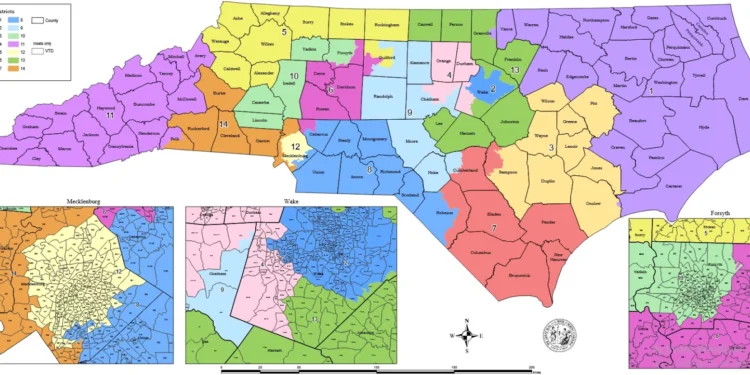October 22, 2025 Story by: Publisher
The North Carolina Legislature approved a new map for the state’s 14 U.S. House districts that is designed to shift the partisan balance in favor of the Republican party. The move will convert the only truly competitive district into a safer GOP-leaning seat.
The legislation, passed in a party-line vote of 65-48 in the state House following earlier Senate approval, makes significant boundary adjustments between the 1st and 3rd Congressional Districts in eastern North Carolina.
Under the proposed map, roughly 500,000 people will be shifted between those districts.
Key changes include moving counties such as Beaufort, Carteret, Craven, Dare, Hyde and Pamlico from the 3rd into the 1st, while Greene, Lenoir, Wayne and Wilson counties move from the 1st into the 3rd.
The result aims to convert the 1st District — currently held by Democrat Don Davis — from a competitive seat into one where Republicans believe they will have an edge. Under the new lines, that district’s partisan lean is projected to shift by double digits toward the GOP.
Currently, Republicans hold 10 of North Carolina’s 14 seats. The new map is aimed at raising that to 11.
Opponents of the measure, including Democrats and voting-rights advocates, sharply criticized the process and the result. They argue the changes amount to partisan gerrymandering, and possibly a racial gerrymander — particularly because the 1st District is majority-Black and has historically elected Black representatives.
Democrats point out that under state law, the Democratic governor, Josh Stein, has no veto power over congressional-redistricting legislation — meaning the only recourse is through the courts.
North Carolina’s move comes amid a wave of mid-decade redistricting in several states — a trend uncommon outside the regular post-census cycle. States like Texas and Missouri (for Republicans) and California (for Democrats) have engaged in similar map redraws aimed at altering House seats ahead of the 2026 elections.
This push is tied in part to the slim margins in control of the U.S. House; for Republicans to hold or enlarge their majority, drawing favorable lines in key states like North Carolina is viewed as essential.
The new map becomes effective barring a successful legal challenge. Courts could intervene if the map is found to violate the Voting Rights Act or constitutional protections against racial discrimination. Democrats and civil-rights groups say they are prepared to sue.
Filing for candidates in the 2026 U.S. House races begins December 1. The newly drawn map therefore will be in place for that cycle.
In late September, A federal judge upheld North Carolina’s state Senate map, rejecting arguments that Republican lawmakers had drawn district lines to weaken the political influence of Black voters.
The lawsuit alleged that the map fractured Black communities in northeastern North Carolina, but U.S. District Judge James C. Dever III — a George W. Bush appointee — concluded that the configuration did not violate the Voting Rights Act. In his 126-page opinion, Dever declined to order the legislature to create a majority-Black Senate district, stating that doing so would require “the odious practice of sorting voters by race.”

















